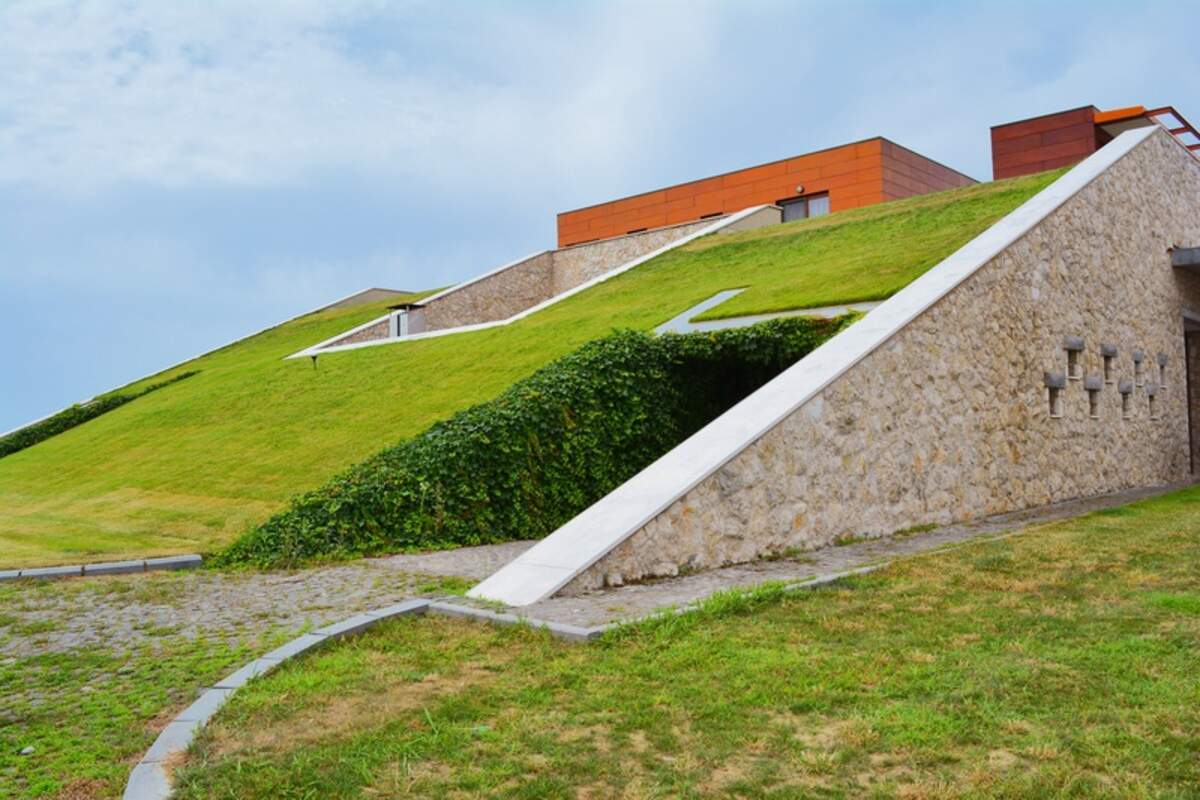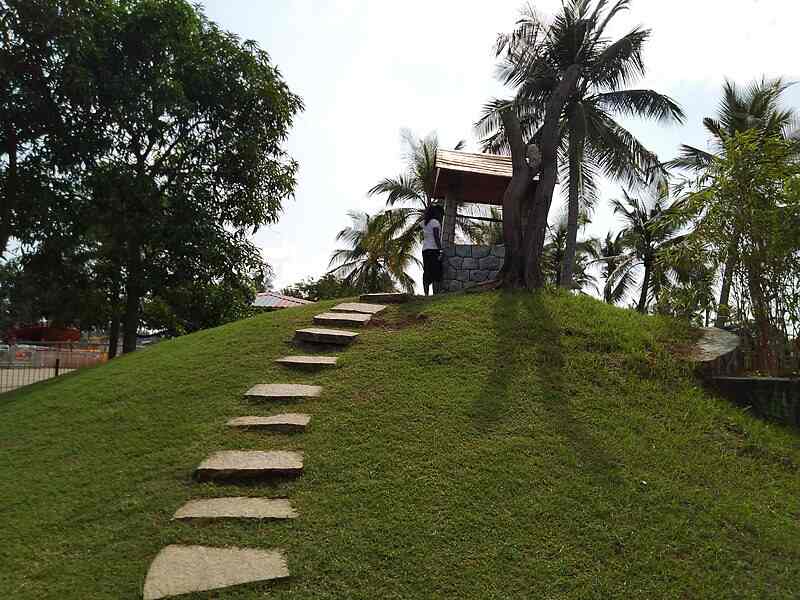
Are you struggling to grow lush grass in the hilly parts of your yard? We’ll show you how to plant grass seed on a slope with a list of essential tools and easy-to-follow, step-by-step instructions.
While flat surfaces are simple to deal with, slopes bring in a whole new level of complexity. You’ve likely felt frustrated seeing your grass seed washed away, property lines disappearing, and your efforts swept away by the wind. That stops now. Growing grass on a slope is easier than you think. Gather your tools (see our checklist below), and follow these five foolproof steps:
Step 1: Choose Your Grass
Choose grasses with strong, deep roots that grow fast. These are great for areas where erosion occurs, as they hold the soil in place and prevent it from washing away on slopes.
Here are a few examples of the best grass seed for slopes:
- Tall fescue: Often a top choice for lawns, tall fescue establishes quickly and has robust, deep roots, making it a prime contender for areas prone to erosion.
- Ryegrasses: Both annual and perennial ryegrasses sprout swiftly, acting as a barrier to soil washout on slopes. Their growth pace helps ensure the ground remains intact, especially during the initial phases of lawn establishment.
If you’re dealing with a gentle slope, there’s a bit more flexibility. You can select grass types better suited to your region’s climate, whether cool-season grasses or warm-season grasses.
Step 2: Prep the Soil
Before you start planting grass seed on a slope, get the area ready for successful germination. With proper soil preparation and maintenance, the germinating seeds have a higher chance of taking root successfully and thriving in the challenging conditions of a slope.
- Clear debris. To prevent any obstructions that might hinder the proper distribution of seeds, remove any obstacles, leaves, or other materials.
- Loosen the soil. Till the top 2-3 inches of soil. This creates a seed-friendly surface, enabling the seeds to settle comfortably into the soil.
- Rake to ensure even growth. This step aids in creating a uniform environment for the germinating seeds, preventing clumps or uneven growth.
- Water the area. Proper moisture is essential for germination, so ensure the soil is adequately moistened. Use tools like sprinklers, hoses, or a water-filled lawn roller. Just be cautious not to over-soak the topsoil or trigger runoff.
- Add fertilizer. Liquid fertilizers are particularly effective on slopes, as they are easily absorbed by the soil and provide essential nutrients to the developing grass plants. Additionally, they contribute to reducing the likelihood of slipping, making the slope safer to navigate.
Step 3: Seed the Slope
Now, it’s time to plant your grass seeds. First, mix the seeds with a small amount of topsoil, creating a mixture that ensures proper contact between the seeds and the soil. This will help promote better seed-to-soil contact, which is crucial for effective germination.
Sprinkle this mixture evenly across the prepared area. Even distribution ensures that each inch of your slope has an equal opportunity for lush, green growth.
The best ratio is two parts seed to one part soil. This careful distribution of seeds sets the stage for healthy growth, as the seeds are effectively nestled within the soil for optimal conditions.
Pro Tip: Hydroseeding can be a game-changer, especially on slopes. By integrating a bonded fiber matrix mulch or a tackifier, your slurry (that perfect blend of seed, water, and mulch) gets an adhesive quality. This ensures the mixture stays put, minimizing the risk of washing away during rainy conditions.
Step 4: Cover and Water the Seeds

Once you’ve sowed the seeds into your sloped terrain, they need protection from the wind and rainwater. After planting, gently use a rake to spread a thin layer of soil over the seeds. Think of it as tucking them in for added safety.
Then, using a lawn roller is essential to press the soil down, guaranteeing your grass seeds are shielded from the weather.
Hydration is the final touch in this phase. A light watering ensures the seeds and soil blend seamlessly. Be watchful to prevent overwatering — the aim is to moisten the ground and the seeds, not to drown them. You should water new grass seed enough to keep the top 1.5 inches of soil moist for the first week or two.
Step 5: Use Erosion Control Mats and Straw
After planting, ensure your seeds are as protected as possible. Erosion control netting, also known as soil erosion control mats, is a great solution for slopes.
These mats act as a protective barrier while also allowing grass to grow through the mesh. They naturally break down over time, so you won’t have any trouble removing them. You can keep them in place with garden staples so they stay secure through windy weather.
Pro Tip: For added protection, consider spreading a thin layer of straw beneath the mat. Think of the straw as a blanket for your seeds. It not only guards them from extreme weather but also helps keep the soil moist, promoting better growth.
Checklist: Tools to Plant Grass Seed on a Slope
Think of this as your personal tool checklist, ensuring each step we discussed above to plant grass seed on a slope is executed perfectly:
- Gardening gloves: Protect your hands while handling soil, seeds, and other materials. Gloves will ensure your hands stay clean and shielded from potential irritants.
- Tiller: You can use a tiller to loosen and cultivate the soil. It’s particularly important on slopes to create a suitable planting bed. Loosening the soil promotes better root penetration and growth.
- Rake: Raking the soil after tilling helps to create an even surface for planting. It also assists in breaking up larger soil clumps and removing debris that might hinder seed germination.
- Lawn roller: You can use a lawn roller to slightly compact the soil after seeding. This step ensures good seed-to-soil contact, which is essential for successful germination.
- Fertilizer: Fertilizer provides essential nutrients to the developing grass plants. Choose a balanced fertilizer that supports healthy root development and overall growth.
- Topsoil: If the existing soil on the slope is of poor quality, adding topsoil can enhance its texture and nutrient content. This promotes better root growth and establishment.
- Straw: Straw helps retain soil moisture, preventing erosion and offering a temporary shield against the sun, reducing the chances of the seeds drying out.
- Erosion control netting: A biodegradable, open-weave fabric that acts as armor against erosion. It helps reduce soil loss in unestablished vegetation.
- Garden staples: Metal pins are commonly used to secure erosion control netting or straw in place.
Frequently asked questions
Seeding on a slope plays a vital role in controlling erosion. When you establish grass or other vegetation on a slope, you essentially provide a protective barrier for the bare soil surfaces, safeguarding them from displacement caused by wind or water. This helps in significantly reducing stormwater runoff, a major contributor to erosion.
Furthermore, the roots of the grass or plants you seed play a critical role in holding the soil together. These roots anchor the soil particles, offering stability and resilience against the forces that typically cause displacement.
Grass can grow well on a slope with a 25% grade. If the slope gets steeper, the difficulty increases. The steepest slope suitable for a lawn is around 50%. If you’re not sure how to plant grass on a steep slope, it’s worth considering the option of a retaining wall to help maintain the terrain’s integrity.
Yes, you can mow a slope, but it’s crucial to follow certain safety guidelines to ensure safety. For instance, you should always avoid mowing upward, as the mower blades can potentially fall toward your legs. It’s recommended to mow sideways across the slope.
Additionally, you should never mow a slope when the grass is wet, such as after rainfall. Wet grass can be slippery, increasing the risk of losing your footing or the mower skidding.
For those using riding mowers on slopes, select one with traction-supporting features. If your current mower doesn’t have these features, consider upgrading the tires to specialty ones designed for better grip on inclined surfaces.
The best way to provide moisture on slopes is by utilizing drip irrigation or soaker hoses. With these techniques, water will be released gradually into the soil, preventing the common issues of runoff and erosion associated with overhead watering.
You can easily create your own watering system by creating small holes in a standard garden hose. Simply place it in the garden, and the water will slowly seep into the ground instead of flowing down the hill.
However, if you’re considering a more complex irrigation system with timed zones and buried pipes, it would be smart to hire a professional.
When to Call a Lawn Care Pro
Planting grass on a slope might seem like a mountainous task, especially if you’re handling a large area or the slope is particularly steep. It doesn’t have to be. Hire a local LawnStarter lawn care pro to ensure everything is done right and to mow that slope once the seeds grow into grass.
Main Image Photo Credit: Pxhere